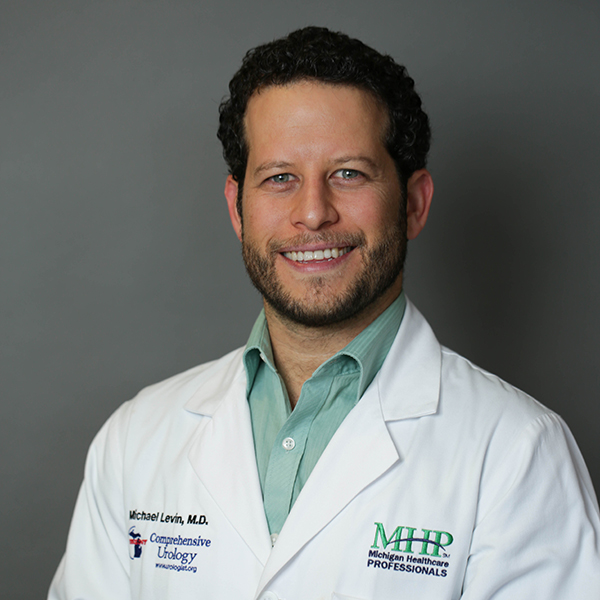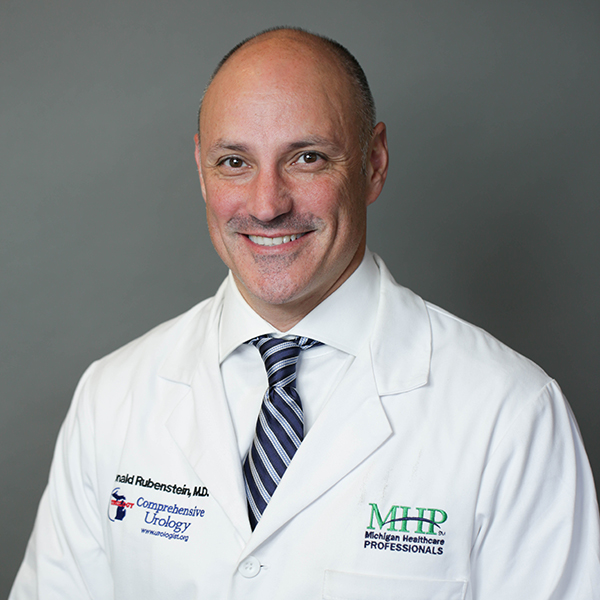Quick Facts
Prostate Cancer
- Affects 1 in 6 men during their lifetime
- Men begin prostate screenings at age 40

Prostate Cancer
Our Prostate Cancer Specialists
Prostate Cancer
The prostate is a small walnut shaped gland in the pelvis of men. It is located next to the bladder and can be examined by getting a digital rectal exam. Prostate cancer is a form of cancer that develops in the prostate gland. It is the second-leading cause of cancer deaths for men in the U.S. About 1 in 9 men will be diagnosed with prostate cancer in their lifetime. This year, nearly 250,000 men will be diagnosed with prostate cancer.
Growths in the prostate can be benign (not cancer) or malignant (cancer).
Benign growths (like benign prostatic hyperplasia (BPH):
- Are rarely a threat to life
- Don’t invade the tissues around them
- Don’t spread to other parts of the body
- Can be removed and can grow back very slowly (but usually don’t grow back)
Malignant growths (prostate cancer):
- May sometimes be a threat to life
- Can spread to nearby organs and tissues (such as the bladder or rectum)
- Can spread (metastasize) to other parts of the body (like lymph nodes or bone)
- Often can be removed but sometimes grow back
Prostate cancer cells can spread by breaking away from a prostate tumor. They can travel through blood vessels or lymph nodes to reach other parts of the body. After spreading, cancer cells may attach to other tissues and grow to form new tumors, causing damage where they land.
When prostate cancer spreads from its original place to another part of the body, the new tumor has the same kind of abnormal cells and the same name as the primary (original) tumor. For example, if prostate cancer spreads to the bones, the cancer cells in the bones are actually prostate cancer cells. The disease is metastatic prostate cancer, not bone cancer. For that reason, it’s treated as prostate cancer in bone.
To understand prostate cancer, it helps to know how the prostate normally works.
The Prostate
The prostate and seminal vesicles are part of the male reproductive system. The prostate is about the size of a walnut and weighs about one ounce. The seminal vesicles are two much smaller paired glands. These glands are attached to each side of the prostate. Some have said that the seminal vesicles look like rabbit ears attached to the prostate. The prostate is below the bladder and in front of the rectum. The prostate surrounds the urethra. The urethra is a tube that carries urine from the bladder out through the penis. This is why men with an enlarged prostate have difficulty urinating. It can disrupt the flow of urine from the bladder.
The main job of the prostate and seminal vesicles is to make fluid to bathe semen. During ejaculation, sperm is made in the testicles, and then moves to the urethra. At the same time, fluid from the prostate and the seminal vesicles also moves into the urethra. This mixture of semen and fluid from the prostate and seminal vesicles forms the ejaculate that passes through the urethra and out of the penis.
When prostate cancer occurs, it starts in the prostate gland and occasionally spreads to the seminal vesicles.
Symptoms
Most men who learn they have prostate cancer are surprised. This is because, when caught early, prostate cancer does not cause symptoms. Symptoms can develop as prostate cancer grows and spreads. These many include:
- Trouble urinating, pain, burning, or weak urine flow
- Blood in the urine (Hematuria)
- Trouble with erections
- Blood in your urine or semen
- Painful ejaculation
- Frequent pain in your lower back, hips or upper thighs
- Dull pain in the lower pelvic area
- Bone pain
If you’re experiencing these symptoms, don’t panic. These symptoms similar to those caused by other noncancerous prostate problems such as enlarged prostate and prostatitis. Your doctor will evaluate you to determine the cause of your symptoms.
Causes
No one knows why or how prostate cancer starts. Autopsy studies show 1 in 3 men over the age of 50 have some cancer cells in the prostate. Eight out of ten “autopsy cancers” found are small, with tumors that are not harmful.
Even though there is no known reason for prostate cancer, there are many risks associated with the disease.
What Are The Risk Factors for Prostate Cancer?
Age
As men age, their risk of getting prostate cancer goes up. It is rarely found in men younger than age 40. Damage to the genetic material (DNA) of prostate cells is more likely for men over the age of 55. Damaged or abnormal prostate cells can begin to grow out of control and form tumors.
Age is a well-known risk factor for prostate cancer. But, smoking and being overweight are more closely linked with dying from prostate cancer.
Ethnicity
African American men have, by far, the highest incidence of the disease. One in six African American men will get prostate cancer. African American men are more likely to get prostate cancer at an earlier age. They are also more like to have aggressive tumors that grow quickly, spread and cause death. The reason why prostate cancer is more prevalent in African American men is unclear yet it may be due to socioeconomic, environmental, diet or other factors. Other ethnicities, such as Hispanic and Asian men, are less likely to get prostate cancer.
Family History
Men with a family history of prostate cancer also face a higher risk of also developing the disease. A man is 2 to 3 times more likely to get prostate cancer if his father, brother or son had it. This risk increases with the number of relatives diagnosed with prostate cancer. The age when a close relative was diagnosed is also an important factor.
Smoking
Studies show prostate cancer risk may double for heavy smokers. Smoking is also linked to a higher risk of dying from prostate cancer. However, within 10 years of quitting, your risk for prostate cancer goes down to that of a non-smoker the same age.
World Area
Prostate cancer numbers and deaths vary around the world but are higher in North America and Northern Europe. Higher rates may be due to better or more screening procedures, heredity, poor diets, lack of exercise habits, and environmental exposures.
Diet
Diet and lifestyle may affect the risk of prostate cancer. It isn’t clear exactly how. Your risk may be higher if you eat more calories, animal fats, refined sugar and not enough fruits and vegetables. A lack of exercise is also linked to poor outcomes. Obesity (or being very overweight) is known to increase a man’s risk of dying from prostate cancer. One way to decrease your risk is to lose weight, and keep it off.
Can Prostate Cancer Be Prevented?
Doing things that are “heart healthy”, will also keep your prostate healthy. Eating right, exercising, watching your weight and not smoking can be good for your health and help you avoid prostate cancer.
Some healthcare providers believe drugs like finasteride (Proscar ®) and dutasteride (Avodart ®) can prevent prostate cancer. Others believe they only slow the development of prostate cancer. Studies do show that men taking these drugs were less likely to be diagnosed with prostate cancer. Still, it is not clear if these drugs are affective so you should talk to your doctor about the possible side effects.
Diagnosis
Screening
“Screening” means testing for a disease even if you have no symptoms. The prostate specific antigen (PSA) blood test and digital rectal examination (DRE) are two tests that are used to screen for prostate cancer. Both are used to detect cancer early. However, these tests are not perfect. Abnormal results with either test may be due to benign prostatic enlargement (BPH) or infection, rather than cancer.
The American Urological Association (AUA) recommends talking with your healthcare provider about whether or not you should be screened. To find out if prostate cancer screening is a good idea, use our Prostate Cancer Screening Assessment Tool. Share your results with your healthcare provider when you talk about the benefits and risks of screening.
The two main types of screenings are:
PSA Blood Test
The prostate-specific antigen (PSA) blood test is one way to screen for prostate cancer. This blood test measures the level of PSA in the blood. PSA is a protein made only by the prostate and prostate cancers. The test can be done in a lab, hospital or healthcare provider’s office.
Very little PSA is found in the blood of a man with a healthy prostate. A low PSA is a sign of prostate health. A rapid rise in PSA may be a sign that something is wrong. Prostate cancer is the most serious cause of a high PSA result. Another reason for a high PSA can be benign (non-cancer) enlargement of the prostate. Prostatitis, inflammation of the prostate, can also cause high PSA results.
A rise in PSA level does not tell us the type of cancer cells present. The rise tells us that cancer may be present.
Talk with your healthcare provider about whether the PSA test is useful for you. If you decide to get tested, be sure to talk about changes in your PSA level with your provider. Make sure to watch our video on the PSA Blood test.
DRE
The digital rectal examination (DRE) helps your doctor find prostate problems. For this exam, the healthcare provider puts a lubricated gloved finger into the rectum. The man either bends over or lies curled on his side on a table. During this test, the doctor feels for an abnormal shape or thickness to the prostate. DRE is safe and easy to do. But the DRE by itself cannot detect early cancer. It should be done with a PSA test
Who Should Get Screened?
Screening is recommended if you are a man:
- Between 55–69 years old
- African–American
- Have a family history of prostate cancer
What are the benefits and risks of screening?
The PSA test and DRE are very important tools. They help to find prostate cancer early, before it spreads. When found early, it can be treated early which helps stop or slow the spread of cancer. This is likely to help some men live longer.
A risk of a PSA test is that it may miss detecting cancer (a “false negative”). Or, the test may be a “false positive,” suggesting something is wrong when you are actually healthy. A false positive result may lead to a biopsy that isn’t needed. The test might also detect very slow growing cancer that will never cause problems if left untreated.
What is a Biopsy?
A biopsy is a type of minor surgery. For a prostate biopsy, tiny pieces of tissue are removed from the prostate and looked at under a microscope. The pathologist is the doctor who will look carefully at the tissue samples to look for cancer cells. This is the only way to know for sure if you have prostate cancer.
The decision to have a biopsy is based on PSA and DRE results. Your doctor will also consider your family history of prostate cancer, ethnicity, biopsy history and other health factors.
Prostate biopsy is usually done using an ultrasound probe to look at the prostate and guide the biopsy. You may be given an enema and antibiotics to prevent infection. For the test, you will lie on your side as the probe goes into the rectum. First, your provider takes a picture of the prostate using ultrasound. Your healthcare provider will note the prostate gland’s size, shape and any abnormalities. He/she will also look for shadows, which might signal cancer. Not all prostate cancers can be seen, and not all shadows are cancer. The prostate gland is then numbed (anesthetized) with a needle passed through the probe. Then, the provider removes very small pieces of your prostate using a biopsy device. The amount of tissue removed depends on the size of the gland, PSA results and past biopsies.
If cancer cells are found, the pathologist will assign a “Gleason Score” which helps to determine the severity/risk of the disease (see Stages for more information).
After a biopsy, you may have blood in your ejaculate, urine and stool. This should go away fairly quickly. If not, or you get a fever, contact your doctor.
Stages
How is Prostate Cancer Graded and Staged?
Grading (with the Gleason Score) and staging defines the progress of cancer and whether it has spread:
Grading
When prostate cancer cells are found in tissue from the core biopsies, the pathologist “grades” it. The grade is a measure of how quickly the cells are likely to grow and spread (how aggressive it is).
The most common grading system is called the Gleason grading system. With this system, each tissue piece is given a grade between three (3) and five (5). In the past, we assigned scores of one (1) and two (2). A grade of less than three (3) means the tissue is close to normal. A grade of three (3) suggests a slow growing tumor. A high grade of five (5) indicates a highly aggressive, high-risk form of prostate cancer.
The Gleason system then develops a “score” by combing the two most common grades found in biopsy samples. For example, a score of grades 3 + 3 = 6 suggests a slow growing cancer. The highest score of grades 5 + 5 = 10 means that cancer is present and extremely aggressive.
The Gleason score will help your doctor understand if the cancer is as a low-, intermediate- or high-risk disease. Generally, Gleason scores of 6 are treated as low risk cancers. Gleason scores of around 7 are treated as intermediate/mid-level cancers. Gleason scores of 8 and above are treated as high-risk cancers.
If you are diagnosed with prostate cancer, ask about your Gleason score and how it impacts your treatment decisions.
Staging
Tumor stage is also measured. Staging describes where the cancer is within the prostate, how extensive it is, and if it has spread to other parts of the body. One can have low stage cancer that is very high risk. Staging the cancer is done by DRE and special imaging studies.
The system used for tumor staging is the TNM system. TNM stands for Tumor, Nodes and Metastasis. The “T” stage is found by DRE and other imaging tests such as an ultrasound, CT scan, MRI or bone scan. The imaging tests show if and where the cancer has spread, for example: to lymph nodes or bone.
These staging imaging tests are generally done for men with a Gleason grade of 7 or higher and a PSA higher than 10. Sometimes follow-up images are needed to evaluate changes seen on the bone scan.
Imaging Tests
Not all men need imaging tests. Your doctor may recommend imaging exams based on results from other tests.
Prostate cancer may spread from the prostate into other tissues. It may spread to the nearby seminal vesicles, the bladder, or further to the lymph nodes and the bones. Rarely, it spreads to the lungs and or other organs.
Your healthcare provider may recommend a pelvic CT scan , an MRI scan or a bone scan to check if your cancer has spread.
What Are The Survival Rates For Prostate Cancer?
Many men with prostate cancer will not die from it; they will die from other causes. For men who are diagnosed, it is better if it is caught early.
Survival rates for men with prostate cancer have increased over the years, thanks to better screening and treatment options. Today, 99% of men with prostate cancer will live for at least 5 years after diagnosis. Many men having treatment are cured. Most prostate cancer is slow-growing and takes many years to progress. One out of three men will survive after five years, even if the cancer has spread to other parts of the body.
Testing and Treatment
If you’ve been diagnosed with prostate cancer, you have lots of questions and may feel overwhelmed by all of the treatment options. We’ll help you understand the risks and benefits of each option so that you can make an informed choice.
Some cancers grow so slowly that treatment may not be needed at all. Others grow fast and are life-threatening so treatment is usually necessary. Deciding what treatment you should get can be complex. Talk with your healthcare team about your options. Your treatment plan will depend on:
- The stage and grade of the cancer (Gleason score and TNM stage)
- Your risk category (whether the cancer is low, intermediate or high risk)
- Your age and health
- Your preferences with respect to side effects, long-term effects and treatment goals
Results from other diagnostic tests will help your provider understand if the cancer can spread or recur (return) after treatment.
Before you decide what to do, you should consider how immediate and long-term side effects from treatment will affect your life, and what you’re willing to tolerate. Also, you should consider that you may try different things over time.
If you have time before you start treatment, consider your range of options. Get a second opinion from different prostate cancer experts. You may need to see another urologist, oncologist or radiation oncologist. Consider the expertise of your doctor before you begin. With more experienced surgeons, the risk of permanent side effects (like incontinence) is lower. Also, it helps to talk with other survivors and learn from their experiences.
In addition, try and get or stay healthy. Eating a well-balanced diet, maintaining a healthy weight, exercising and not smoking are all important factors when fighting prostate cancer..
Moreover, don’t ignore your emotions. Think about how you’re coping with this diagnosis. Many men who have prostate cancer feel worried, stressed and angry. You and those that care about you may need to consider professional counseling.
Treatment choices for prostate cancer include:
Surveillance
- Active Surveillance
- Watchful Waiting
Localized Therapy
- Surgery
- Radiation Therapy
- Cryotherapy
- Focal Therapy
Systemic Therapy
- Hormonal Therapy
- Chemotherapy
- Immunotherapy
What is Active Surveillance?
Active surveillance does not actively treat prostate cancer. It monitors the cancer growth with regular PSA tests, DREs and periodic biopsies. A schedule for tests will be set with your provider. To help your provider do these biopsies, a multiparametric magnetic resonance imaging (pmMRI) exam might be done. With active surveillance, your doctor will know very quickly if the cancer grows. If that happens, then he/she will suggest next steps for you. At that point, radiation and surgery may be the best treatment options.
What are the Benefits, Risks and Side Effects of Active Surveillance?
Active Surveillance is best if you have a small, slow growing (low-risk) cancer. It is good for men who do not have symptoms. If you want to avoid sexual, urinary or bowel side effects for as long as possible, this may be the treatment for you. Active surveillance allows men to maintain their quality of life longer without risking the success of treatment (if and when it’s needed). Action is taken only if the disease changes or grows. For many men, they never need more aggressive treatments.
Active surveillance is mainly used to delay or avoid aggressive therapy. On the other hand, this method may require you to have several biopsies over time to track cancer growth.
What is Watchful Waiting?
Watchful waiting is a less involved system of monitoring the cancer without treating it. It does not involve regular biopsies or other active surveillance tools. It is best for men with prostate cancer who do not want or cannot have therapy. It is also good for men who have other medical conditions that would interfere with more aggressive forms of treatment.
What are the Benefits, Risks and Side Effects of Watchful Waiting?
The main benefit of the watchful waiting treatment is that there are no treatment-related risks, complications or side effects. Also, it is low cost.
The risk of watchful waiting is that the cancer could grow and spread between follow-up visits. This makes it harder to treat over time.
What is Radical Prostatectomy (Surgery) for Prostate Cancer?
There are three types of radical prostatectomy surgery:
Robotic Assisted Laparoscopic Radical Prostatectomy (RALP)
Robotic Assisted Laparoscopic Radical Prostatectomy (RALP) is the most common type of prostate cancer surgery done today. The surgeon is assisted with a robotic system that holds and guides the laparoscopic surgical tools and camera. It also allows the prostate to be removed through tiny ports placed in your belly. In experienced hands, RALP and retropubic prostatectomy (see below) have similar outcomes. There is also less blood loss with robotic surgery than other methods.
Retropubic Open Radical Prostatectomy
For this procedure, your surgeon will make a cut (incision) in your lower belly and remove the prostate through this opening. The entire prostate gland is removed. Your surgeon can assess the prostate gland and surrounding tissue at the same time, while reducing injury to nearby organs. There can be enough blood loss to need a transfusion.
Laparoscopic Radical Prostatectomy
This surgery uses small cuts in the abdomen to remove the prostate with small tools and a camera. This surgery has mostly been replaced with robotic assisted laparoscopic surgery.
What to Expect After the Prostate is Removed
After surgery, your surgeon will review the final pathology report. Together you will make plans for next steps.
What Are The Benefits, Risks and Side Effects of Surgery?
The main benefit of a radical prostatectomy is the prostate with cancer is removed. This is true as long as the cancer hasn’t spread outside the prostate. Surgery also helps the healthcare provider know if you need more treatment.
The goal of surgery is to get a PSA value of less than 0.1 ng/mL for 10 years. Surgery is often a good choice if prostate cancer has not spread beyond the prostate.
Surgery always comes with risks. Some complications from surgery can happen early and some later. Bleeding or infection can happen with any major operation, so you will be monitored to prevent or manage these problems.
Not everyone has the same side effects for the same amount of time. With surgery (and with radiation therapy), there are two main side effects to consider: erectile dysfunction (ED) and urinary incontinence (a loss of urine control). For some men, surgery can relieve pre-existing urinary obstruction. Most men with these side effects find ways to manage them over time.
Erectile Dysfunction and Sexual Desire
All men have some form of erectile dysfunction after prostate surgery. Erectile dysfunction is the inability of a man to have an erection long enough for satisfying sexual activity. Nerves involved in the erection process surround the prostate gland, and they can be affected by surgery. They can also be affected by radiation treatment. These nerve bundles help control blood flow to the penis. The length of time ED lasts after treatment depends on many things, including how firm your erections are before treatment. Sometimes, it may take one year or longer to recover erectile function. In the meantime, your doctor may have ED treatment options for you. If it’s possible, nerve-sparing surgery may help prevent long-term damage. Older men have a higher chance of permanent ED after this surgery.
It may surprise you to know that men are still able to have an orgasm (climax), even after a radical prostatectomy. An erection is not needed to climax. There will be very little, if any, fluid with an orgasm. In addition, you can no longer cause a pregnancy after surgery. This is because the prostate, seminal vesicles, and connections to the testicle were removed and the vas deferens was divided during surgery. Planning for fertility preservation in advance of surgery is an option for men who want to have children.
It is important to know that sexual desire is not lost with this surgery or radiation treatment. The exception to this is if hormones are also given as part of treatment, (usually given temporarily with radiation therapy).
Incontinence
Incontinence is the inability to control your urine. After prostate cancer surgery, you may experience one or more type of Incontinence.
Stress Incontinence – is urine leakage when coughing, laughing, sneezing or exercising. It is the most common type of urine control problem after radical prostatectomy.
Overactive Bladder (Urge Incontinence) – is the sudden need to go to the bathroom even when the bladder is not full because the bladder is overly sensitive. This type of incontinence is the most common form after radiation treatment.
Mixed Incontinence – is a combination of stress and urge incontinence with symptoms from both types.
Continuous Incontinence – is the inability to control urine at any time. It is not very common.
Because incontinence may affect your physical and emotional recovery, it is important to understand your treatment options.
What is Radiation Therapy?
Radiation therapy uses high-energy rays to kill or slow the growth of cancer cells. Radiation can be used as the primary treatment for prostate cancer (in place of surgery). It can also be used after surgery if the cancer is not fully removed or if it returns.
Radiation therapy mostly involves photon beams or proton beams. Photon beams make up traditional x-rays. They carry a very low radiation charge and mass, and can scatter to nearby health tissue. On the other hand, proton beams have more charge and heavy mass and can target deep tissue. A physician can direct proton radiation treatment to the specific site of cancer, minimizing damage to nearby healthy tissue.
Before you begin, it helps to ask your doctor(s) why they recommend one type of radiation therapy over another.
There are two primary kinds of radiation therapy used for prostate cancer:
• External beam radiation therapy
• Brachytherapy (internal radiation)
External Beam Radiotherapy
Traditionally, External beam radiation therapy (EBRT) has used the photon (x-ray). Photon-based external-beam x-rays may damage nearby healthy tissue. That damage can cause side effects. Your healthcare provider may be able to offer three-dimensional conformal radiotherapy (3DCRT) or intensity-modulated radiotherapy (IMRT) instead. Some newer 3DCTR machines have imaging scanners built into them. 3DCRT creates 3D digital data to map the shape, size and location of tumors. It allows higher doses of radiation to be delivered to cancer cells while protecting surrounding healthy tissue.
Proton Beam Therapy (PBT) is another type of EBRT, but it uses the proton. It uses a machine called a synchrotron or cyclotron to speed up and control the protons. High-energy protons can travel deeper into body tissue than low-energy photons. With proton therapy, radiation does not go beyond the tumor, so nearby tissue is not affected. There are fewer side effects. Intensity-modulated proton beam therapy (IMPT) is a new way to deliver targeted PBT, but these machines are expensive and are not offered everywhere.
Stereotactic Body Radiation Therapy (SBRT) delivers large doses of radiation to exact areas, such as the prostate, with advanced imaging. The entire course of treatment is given over a shorter period, for just a few days. SBRT is often known by the names of machines that deliver the radiation, such as Gamma Knife®, X-Knife®, CyberKnife® and Clinac®.
With any radiation treatment, the side effects should be discussed with you before you begin.
Prostate Brachytherapy (Internal Radiation Therapy)
With brachytherapy, radioactive material is placed directly into the prostate using a hollow needle. There are two types of brachytherapy: low dose rate (LDR) brachytherapy and high dose rate (HDR) brachytherapy.
LDR brachytherapy is when your doctor uses a thin needle to insert radioactive “seeds” (the size of a rice grain) into the prostate. These seeds send out radiation, killing the prostate cancer cells nearby. In LDR, the seeds are left in the prostate even after treatment is finished.
HDR brachytherapy is when your doctor puts radiation into your prostate using a slightly larger hollow needle to insert a thin catheter. This catheter stays in your body until treatment is done. The radiation source stays in your prostate for a short period of time. Once your treatment is done, all radioactive material is removed.
Anesthesia is needed to insert the needles for both LDR and HDR brachytherapy. You may need to stay in the hospital overnight.
Sometimes radiation therapy is combined with hormone therapy to shrink the prostate before starting. Or, hormone therapy may be combined with external beam therapy to treat high-risk cancers.
What are the Benefits, Risks and Side Effects of Radiation Therapy?
The benefit of radiation therapy is that it is less invasive than surgery. Whether the radiation is given externally or internally, this treatment is effective for early stage prostate cancer. Some need both types of radiation combined to treat their cancer.
The main side effects of radiotherapy are incontinence and bowel problems. Urinary problems usually improve over time, but in some men they never go away. Erectile dysfunction, including impotence, is also possible. Many men feel tired for a few weeks to months after treatment.
If hormone therapy is used with radiation, sexual side effects are common. These can include loss of sex drive, hot flashes, weight gain, fatigue, decreased bone density and depression. Fortunately, these side effects can be managed and usually go away when hormone therapy is stopped.
It helps to work with your radiologist before you begin treatment to prepare for any known side effects in advance. Follow-up visits with your healthcare team will help you address any new problems.
What is Cryotherapy?
Cryotherapy, or cryoblation, for prostate cancer is the controlled freezing of the prostate gland. The freezing destroys cancer cells. Cryotherapy is done under anesthesia. This treatment is for men who are not good candidates for surgery or radiotherapy because of other health issues.
For this procedure, the prostate is imaged and measured. Special needles called “cryoprobes” are placed in the prostate under the skin. The needles are guided by ultrasound, to direct the freezing process. A catheter will be used in the hospital until you can urinate on your own. After cryotherapy, a patient is monitored with regular PSA tests and in some cases a biopsy.
What are the Benefits, Risks and Side Effects of Cryotherapy?
Cryotherapy has been found to have some side effects. You may experience incontinence and other urinary or bowel problems at first. Erectile dysfunction is likely.
Worth noting is the risk of a fistula. A fistula is a channel that forms after surgery between the urethra and the rectum. This may cause diarrhea or bladder infections.
What is HIFU and Focal Therapy?
The types of High-intensity Focused Ultrasound (HIFU) and Focal Therapy are:
• High-intensity focused ultrasound (HIFU). HIFU uses the energy of sound waves to target and superheat the tumor to kill cells (with the help of MRI scans). It can be used for the whole gland.
• Focal cryoablation. This uses a needle-thin probe to circle the tumor with a special solution that kills the tumor by freezing it.
• Irreversible electroporation. This uses a “NanoKnife” to pass an electrical current through the tumor. The electricity creates very tiny openings (called pores) in the tumor’s cells, leading to cell death.
For men with small, localized prostate tumors, focal therapy may be an option. Focal therapy is a general term for a few methods. They kill small tumors inside the prostate, without destroying the whole gland or healthy tissue nearby. There are a few types of focal therapy in clinical trials.
What are the Benefits, Risks and Side Effects of Focal Therapy?
Ideally, focal therapy would lead to fewer side effects including changes in urinary function. The long-term benefits of focal therapy are not yet known. Research is being done to study this further. Right now, the FDA has approved this method to destroy prostate tissue, but not clearly to treat prostate cancer. Because many of these treatments are so new, insurance coverage is not often available.
What is Hormonal Therapy or Androgen Deprivation Therapy (ADT)?
Prostate cancer cells use the hormone testosterone to grow, similar to our need for food. Hormonal therapy is also known as androgen deprivation therapy (ADT). It uses drugs to block or lower testosterone and other male sex hormones that fuel cancer. ADT essentially starves prostate cancer cells of testosterone. ADT is used to slow cancer growth in cancers that are advanced or have come back after initial local aggressive therapy. It is also used for a short time during and after radiation therapy.
Hormone therapy is done surgically or with medication:
Surgery: Removes the testicles and glands that produce testosterone with a procedure called an orchiectomy.
Medication: There are a variety of medications used for ADT. There are two types that are used at first. One is the injection of luteinizing hormone releasing hormone (LH-RHs) inhibitors. These are also called either agonists or antagonists. They suppress the body’s natural ability to turn on testosterone production. A second type (which is often given with the first type) are called non-steroidal anti-androgens. These pills block testosterone from working.
These therapies have been used for many years and are often offered as the first option for men who can’t have or don’t want other treatments. Hormone therapy usually works for a while (maybe for years) until the cancer “learns” how to bypass this treatment.
There are new medications available in recent years that may be used after other hormone therapy fails. This condition is called “castration-resistant prostate cancer” (CRPC).
To block the production of androgens in CRPC patients, there are a few options. The drug Abiraterone (Zytiga), given with prednisone, is one option that blocks an enzyme called CYP17, to stop these cells from making androgens. Another option is a drug, enzalutamide (Xtandi ®) that blocks the testosterone from working in a different way. This medication blocks signals in cells that tell it to grow and divide. Like other hormone therapies, these options also only work for a while. When they stop working, chemotherapy may be an option.
What Are The Benefits, Risks and Side Effects of Hormone Therapy?
Hormone therapy has been linked to heart disease, diabetes and the loss of bone. You should discuss these risks with your doctor before you begin this treatment for prostate cancer.
Hot flashes and fatigue are also short-term side effects of hormone treatment. The same is true for the loss of sexual drive.
What is Chemotherapy?
Chemotherapy uses drugs to destroy cancer cells anywhere in the body. It is used for advanced stages of prostate cancer. It is also used when cancer has metastasized (spread) into other organs or tissue. The drugs circulate in the bloodstream. Because they kill any rapidly growing cell, they attack both cancerous cells and non-cancerous ones. Dose and frequency are carefully controlled to reduce the side effects this may cause. Often, chemotherapy is used with other treatments. It is not the main treatment for prostate cancer patients.
Many chemotherapy drugs are given intravenously (with a needle in a vein). Others are taken by mouth. They are given in the healthcare provider’s office or at home. You generally do not need to stay in the hospital for chemotherapy. They are often given once per month for several months.
What are the Benefits, Risks and Side Effects of Chemotherapy?
Over the last 10 years, chemotherapy has helped many patients with CRPC. Recently, chemotherapy has also been found to help patients with advanced prostate cancer when given at the same time as standard hormone therapy. Yet, chemotherapy may only works for a while.
The side effects from chemotherapy should be considered. Side effects depend on the drug, the dose and how long the treatment lasts. The most common side effects are fatigue (feeling very tired), nausea, vomiting, diarrhea and hair loss. A change in your sense of taste and touch is also possible. There is an increased risk of infections and anemia because of lower blood cell counts. Most of these side effects can be managed, and lessen once treatment ends.
What is Immunotherapy?
Immunotherapy stimulates your body’s immune system to find and attack cancer cells. There are several approaches used in immunotherapy. Most of these are now in clinical trials and have not yet been approved for routine use.
Provenge® is one type of immunotherapy that is already FDA approved. It has been shown to help slow cancer growth in men with advanced prostate cancer. For this treatment, the medical team must remove immature immune cells from the man with advanced prostate cancer. Then the cells are re-engineered to recognize and attack prostate cancer cells, and put back into the body.
What are the Benefits, Risks and Side Effects of Immunotherapy?
While cancer doctors are excited about the potential of immune therapies, clinical trials have not yet shown clear successful results. So far, most immunotherapy approaches have only mild to moderate side effects.
Clinical Trials
Clinical trials are research studies involving real patients to test if a new treatment or procedure is safe, effective and maybe better than established options. The goal is to learn which treatments work best for certain illnesses or groups of people.
Clinical trials follow strict scientific standards. These standards help protect patients and produce more reliable study results.
Are you interested in participating in a clinical trial for prostate cancer? Ask your doctor if you qualify for a specific prostate cancer trial. Learn as much as you can about the benefits and risks of the study.
Advanced Prostate Cancer Treatment Options
Thirty percent of men treated for early-stage prostate cancer face recurrence, often a decade after initial treatment. Thankfully, many new treatment options exist slow the progression of the cancer. These treatments aren’t curative, but they allow men to live longer with minimal disruption to their normal lives.

Frequently Asked Questions
In general, men over age 40 whose life expectancy is greater than 10 years should consider being screened for prostate cancer. Urology San Antonio has developed these recommendations outlining who should be screened and how frequently.
Thanks to screening, most prostate cancer is caught early, when it is still confined to the prostate. Nearly 100% of men who are treated for early-stage prostate cancer are cancer free 5 years later.
The Alamo chapter of the Us TOO Prostate Cancer Education and Support network meets monthly to provide educational opportunities and a time for you to connect with other patients, survivors, and caregivers affected by prostate cancer. The group is facilitated by volunteer leaders.
Urinary incontinence or bladder leakage is a potential side effect of prostate cancer treatment. Thanks to the precision of newer treatment techniques such as robotic surgery and IMRT, the incidence of incontinence is lower than it was in the past, and most men do not experience incontinence after their initial recovery. For men who do face incontinence, treatment options ranging from pelvic floor physical therapy to corrective surgery exist.
Erectile dysfunction is a potential side effect of prostate cancer treatment. If your erection quality before treatment was good, you may regain your pre-treatment functionality. If your erection quality was poor prior to treatment, returning to your pre-treatment functionality is less likely and you may require treatment for ED.
Request an appointment now
Getting an accurate diagnosis can be one of the most impactful experiences that you can have — especially if you’ve been in search of that answer for a while. We can help you get there.


























